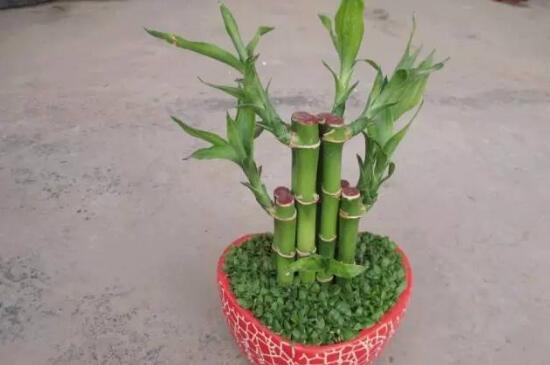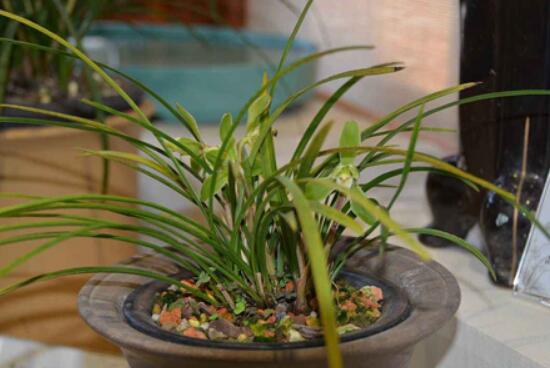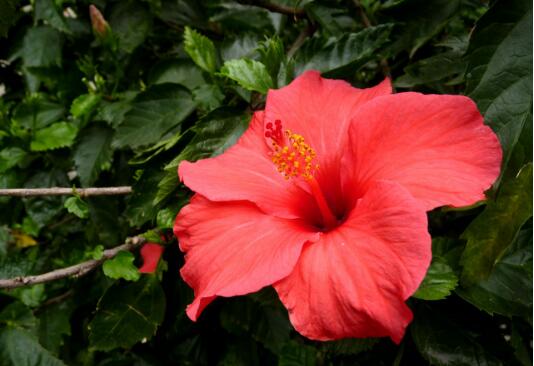How to propagate Lily Bamboo and the method of Cuttage Propagation / rooting by cutting in Spring
For lily bamboo, we must be no stranger, it often appears in the form of water in the living room, office and other places, has an excellent ornamental. But is a pot of lily bamboo too monotonous? It's time to get a few more pots. If you don't buy it in the past, you might as well breed it yourself. How can lily bamboo breed? The following is the cutting propagation method of lily bamboo, let's go and have a look!
How to propagate, cuttage / sow lily bamboo

When it comes to breeding lily bamboo, there are generally two methods, cutting and sowing. Among them, cutting is suitable for indoor flower friends, that is, cutting a branch and inserting it into the soil to wait for rooting; sowing is suitable for mass propagation, sowing lily bamboo seeds into the soil, waiting for its seedlings to grow to a certain height and transplanting.
2. Two propagation methods of lily bamboo (1) cutting propagation of lily bamboo
1. Cutting time
Cutting lily bamboo is generally selected in spring and autumn, when the plant activity is the best, and the rooting rate is higher after cutting.
2. Cuttings selection
In the method of cutting propagation of lily bamboo, the selection of cuttings is particularly important, it has been selected, and the whole propagation process is basically successful. Cuttings method: in the healthy lily bamboo pot, cut the robust branches as cuttings, each branch length of about 10 cm, if there are leaves above, it is best to cut off more than half, all cut off is also OK.
3. Cutting substrate
According to the growth habits of lily bamboo, the cutting substrate prepared for it is preferably clean coarse river sand with good permeability, which is more conducive to rooting after cutting.
4. Cuttings start
Insert the treated cuttings into the substrate and water thoroughly. After that, cover the flowerpot with a plastic bag to keep the soil moist, and then put it in a room with better light. After doing so, it can take root in 15-25 days, and then it can be maintained according to the breeding method of lily bamboo.
(2) sowing and propagation methods of lily bamboo.
Lily bamboo can obtain seeds after flowering, so in addition to cutting, the propagation method of lily bamboo can also be used by sowing method. A mixture of plant nutrient soil, rotten leaf soil and river sand was used as the sowing bed, and then the lily bamboo seeds were sown on it in spring and summer and kept at room temperature for 20-25 ℃. The seedlings could germinate soon, and the seedlings could be moved when the seedlings grew to a certain extent.
Generally speaking, the propagation of lily bamboo, whether cutting or sowing, can be successful, but the most suitable for indoor florists is still cutting. Of course, the method is dead, people are alive, we can choose according to the actual situation. With regard to the breeding method of lily bamboo, the editor has introduced this, hoping to give you some help.
The cutting method of lily bamboo is complete, and it takes root in half a month!
The cutting method of lily bamboo is complete, and it takes root in half a month!
1. The specific method of cutting is to first cut off a stem in spring, with a general length of about 5 to 10 centimeters, preferably with no leaves above, or the kind of base tip that can be easily withered and used. Grow some branches with stem tips in dark places in the house for a long time, insert them into relatively clean coarse river sand and water thoroughly.
2. Then we have to cover the whole plant with a plastic bag to keep the soil moist, and then put it in a room with better light, which will usually take root after 25 days. Or it is OK to insert the branch that has been cut off before, if it is in the environment of 25 degrees, it can take root in 15 days.
3. Lily bamboo is a kind of plant that likes warm and humid environment, and it is more suitable to grow at a temperature of 20 to 27 degrees, even in winter, it is better to be above 10 degrees. If the air is too dry, it may cause the leaves to turn yellow. There is more like the sun, not suitable for Taiyin, a little shade is the best. Moisture, it is more resistant to drought, can also be resistant to moisture, the requirements are not so strict. The matrix likes sandy loam with good drainage, moist soil and fertile soil.
How to propagate Lily Bamboo Propagation method of Lily Bamboo
Lily bamboo alias short-leaf bamboo banana is an evergreen shrub or small tree of the tequila family. It is a high-grade foliage plant widely cultivated in China and more popular in South China. So how do lilies reproduce? Next, let's introduce the breeding method of lily bamboo.
Growth environment of lily bamboo
Lily bamboo likes high temperature and humidity, the suitable growth temperature is 20 ℃ ~ 28 ℃, drought and humidity tolerance, high temperature, vigorous growth, dry and cold winter easy to cause leaf tip withering. Should be semi-overcast, avoid strong direct sunlight, overwintering requires more than 12 ℃, soil and fertilizer requirements are not strict. Potted soil can be used in garden mud: peat soil: chicken manure = 6:4:1 and then compost for half a year.
Propagation methods of Lily Bamboo
Cuttage propagation
Cutting propagation can be carried out from March to May. The robust and mature branches of the same year are taken and cut to grow 8~10cm. The hard stem retains 3-4 buds and the shoots retain 3-4 leaves. The bed soil is unconsolidated sandy loam or peat soil with good drainage and disinfection. After insertion, cover with 80% sunshade net and water thoroughly. After that, spray water once or twice a day, each time for 3-5 minutes, and take root in about 30-35 days. For example, 400 times of the rooting agent "Root Sun" and yellow mud are mixed into mud, and the cuttings are dipped in some mud. After treatment, the mud is dried and inserted into the seedling pond. When inserted into the seedling pond, you should first use a stick to insert the seedling, so as to prevent the yellow mud from breaking away from the cuttings and affecting rooting. It can take root about 20-25 after insertion.
Sowing and reproduction
Sowing and reproduction should be carried out in spring or summer. Before sowing, the soil and seeds should be strictly disinfected to prevent diseases and insect pests during the growing period. The soil should be disinfected with 70% thiophanate, and 90% trichlorfon should be used to kill the soil. Seeds can be sown as they are picked, or stored until spring and summer before sowing. In order to improve the germination rate of seeds and reduce the trouble of seed storage, the seeds can be sowed directly after drying.
Soak the seeds with 0.5% potassium permanganate solution for 30 minutes before sowing, remove and place the seeds in the bamboo basket to dry after sowing, and then sow the seeds after drying. After sowing, strengthen the field management of the nursery, keep the soil moist, the temperature is 20 ℃ ~ 25 ℃, and emerge about 25 days after sowing. When the seedlings grow to 3~5cm, weeds should be removed in time and fertilized with inter-seedlings. Thin human feces and urine with a concentration of 3% to 5% and 1% to 2% rotten cake fertilizer were applied every 7 to 10 days.
In the future, 0.5%-0.8% compound fertilizer is used to irrigate around the roots of the seedlings, and the solution should not be poured on the leaves as far as possible. Sprinkle water on the leaves after fertilization to avoid burning the leaves. When the root system of the seedling grows to 3~5cm, it can be transplanted into the pot.
Upper basin management
When the root system of lily bamboo seedlings grows to 3~5cm, it can be transplanted into the pot. If the pot is too late, the growth of the seedlings will be weak, which will affect the growth and development in the future. Lily bamboo is a semi-shady flower, and the semi-shady environment and moist, fertile and well-drained soil should be selected when planting in order to meet the requirements of environmental conditions in the process of growth and development.
The plant should carry soil clot when transplanting, and it can also be transplanted in the growing season, but all the branches and leaves of the new shoots of the same year should be removed before transplanting to keep the soil moist. Lily bamboo is not strict to the environment, but likes semi-overcast, hot and dry climate, and is sensitive to water and fertilizer, so it is necessary to do a good job of watering, fertilization, core pruning, light, temperature, humidity and other technical work in cultivation and management.
Watered lily bamboo has a good tolerance to water, mild drought and wet stains will not damage too much, but it is better to irrigate the surface layer of basin soil after drying, which is beneficial to its growth. Alternating dry and wet watering can make the branches and leaves dense, compact branches and high ornamental value.
10-15 days after transplanting, fixed root fertilizer can be applied, 10% urea can be irrigated, nitrogen fertilizer can be applied mainly in seedling stage and shoot stage, nitrogen, phosphorus and potassium compound fertilizer or organic fertilizer can be applied in prosperous growth period, and the principle of frequent application of thin fertilizer should be grasped. In addition, fertilizer should be stopped in high temperature season or winter, and certain mature organic fertilizer can be added as base fertilizer when changing pot and soil every spring to ensure its good growth.
After pruning and pruning into the basin, when the seedlings grow to 8~10cm, the hearts can be removed, and the second time when the new shoots are high 4~6cm, so many times, in order to achieve fullness. Lily bamboo has a certain persistent root, can grow new branches from the root, so the plant shape grows well. Lily bamboo is more resistant to pruning, so it is best to strengthen fertilizer and water management before and after pruning to facilitate the growth of new branches and leaves. Pruning is mainly based on integral type, and it can also be combined with cutting propagation.
The lily bamboo likes the light, and avoids the direct sun in summer, such as family maintenance can put it under the south window or balcony, only avoid direct light in summer, other seasons had better be able to give certain light, otherwise the golden stripes in the middle of the leaves will be dim, disappear, seriously reduce the ornamental value.
Temperature lily likes to grow in warm and humid environment, and it can also grow in high temperature environment. The optimum growth temperature is 20 ℃ ~ 30 ℃. The overwintering temperature should be kept above 10 ℃, and freezing damage will occur when the temperature is below 5 ℃.
Humidity the most suitable growth humidity of lily bamboo is 75%-85%. A certain amount of air humidity is needed in the growth process, otherwise the leaf color is dim and the glossiness decreases. Water can be frequently sprayed to the plant during the growing period, and if conditions permit, it is best to increase moisture and humidity in the environment.
- Prev

How to propagate bluegrass, four propagation methods of bluegrass (cutting ramet is the most practical)
Orchid, that is, orchid, it is a traditional Chinese flower, with plum, bamboo, chrysanthemum and called four gentlemen, loved by the majority of flower friends. In life, many people keep bluegrass at home, but is a pot too monotonous? It's time to breed a few pots, so how does bluegrass reproduce? Here are four propagation methods of bluegrass
- Next

How to propagate hibiscus flower? the propagation method of hibiscus flower is mainly cutting propagation.
Hibiscus flower is a common flower plant in people's life, which has high ornamental value and is cultivated in all parts of our country. With the increase in the number of farmers, people are more concerned about its reproduction, about how to breed hibiscus flowers. What are the breeding methods of hibiscus flower
Related
- Fuxing push coffee new agricultural production and marketing class: lack of small-scale processing plants
- Jujube rice field leisure farm deep ploughing Yilan for five years to create a space for organic food and play
- Nongyu Farm-A trial of organic papaya for brave women with advanced technology
- Four points for attention in the prevention and control of diseases and insect pests of edible fungi
- How to add nutrient solution to Edible Fungi
- Is there any good way to control edible fungus mites?
- Open Inoculation Technology of Edible Fungi
- Is there any clever way to use fertilizer for edible fungus in winter?
- What agents are used to kill the pathogens of edible fungi in the mushroom shed?
- Rapid drying of Edible Fungi

